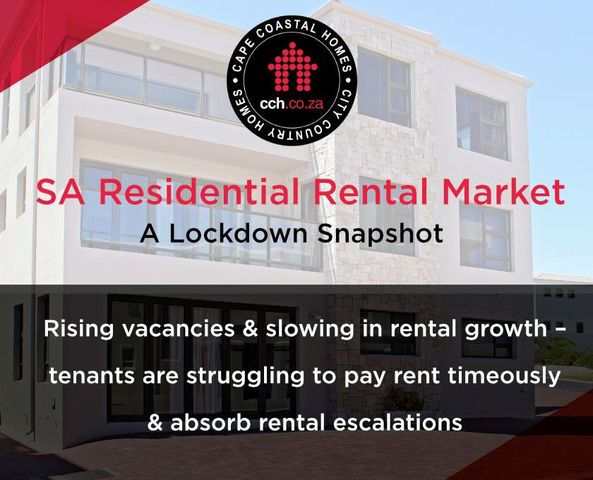SA Residential Rental Market - A Lockdown Snapshot
The South African residential property market has had five months of high sales activity since the lockdown measures were relaxed down to level 3, especially from first-time home buyers eager to benefit from the current low interest rates. However, the residential rental market has been struggling and is experiencing rising vacancies and a slowing in rental growth - as tenants are struggling to pay rent timeously and are becoming less able to absorb rental escalations.
Good tenants are getting scarcer
The pressure felt in the rental market started well before the pandemic hit. According to John Loos, FNB's Property Strategist, the rental component of the residential market has seen a significant multi-year slowing in rental growth. This is because as the country's economic growth slowed increasingly tenants were struggling financially to pay their rent timeously and absorb rental escalations.
The weakening of the rental market is most clearly seen in the drop of the percentage of tenants that are in good standing with their landlords. TPN's survey indicate a gradual drop from a decade high of 85.95% as at the 3rd quarter of 2014 to 81.52% by the 1st quarter of 2020. Then came the severe lockdown in the 2nd quarter in response to the Covid-19 pandemic and the percentage of tenants in good standing dropped sharply to 73.5%. A breakdown of the situation in the three top performing provinces showed Western Cape in the lead with 80.86% of the tenants in the province in good standing, followed by noticeably lower figures in KZN (70.83%) and Gauteng (71.1%). Overall, Loos notes that the Western Cape weathered the Covid-19 storm best of the three leading provinces.
"We believe that these economy-related pressures have contributed to a greater oversupply of rental space relative to demand, with new household formation slowing and a portion of existing households 'shutting down', as reflected in a rising residential rental property vacancy rate," Loos explains.
More tenants are in arrears
It is now common knowledge that thousands of tenants were unable to pay rent during the 'hard' months of lockdown due to loss of income or because they lost their jobs. PayProp data shows that for June through August, on average tenants were in arrears with just over one month's rent (105% of rent). Before lockdown this figure was below 80% says Johette Smuts, data analyst with PayProp. She adds that the number of tenants in arrears also increased from 19% in March to 26% in May. "Many people returned to work again in June, so we see that this number dropped slowly from June to August - but there are still more tenants in arrears than before lockdown," Smuts says.
Increase in residential rental vacancy rate
On a more positive note, the sudden drop in the interest rate combined with a favourable home loan climate, has also seen an unexpected uptick in home buying activity, also from former tenants for whom it has become cheaper to buy than to rent. A Q3 FNB survey estimate that first-time buyers are responsible for 24% of total buying in an expanding market, up from 19% a year prior.
Loos confirms that the sudden reduction in the interest rate has increased the attractiveness of owning a home relative to the rental option. This buying spree further contributed to the exodus of tenants, increasing the current vacancy rate. From a low of 5.35% in the final quarter of 2017, the TPN National Average Vacancy Rate has steadily been climbing over the last few years to reach 11.39% by Q3 of 2020, and it is still climbing says Loos.
In fact, the average rental inflation at 1.4% is now slower than the FNB House Price inflation rate which accelerated to 3.14% year-on-year in September this year. This does not bode well that the rental market will soon see an upswing in rental growth. According to Loos it is more likely that the rental market could weaken further in the coming months with a period of average rental deflation possible in 2021.
Covid-19 is changing residential property rental needs
The lockdown and ongoing need for social distancing has changed what people look for in an apartment and these changes appear to be long-term. "We've seen that with the lockdown-imposed work-from-home situation, tenants are now less likely to be driving into an office even after lockdown. This means that they can consider renting in suburban areas, further from the city, where rental properties are often priced more affordably. In addition, their new work-from-home status means that they'll likely need a study or additional bedroom for a home office," says Smuts.
Keeping & placing good tenants - a landlord challenge
With so many good tenants moving out to become first-time homeowners, the biggest challenge for rental and estate agents will be finding the remaining good tenants says Smuts. "By that we mean those with acceptable credit scores, sufficient funds for a once-off damage deposit and sufficient monthly disposable income to pay the rent. The tenants that remain also have far greater bargaining power when it comes to rental prices, as the oversupply of stock affects the rental market too," she explains.

